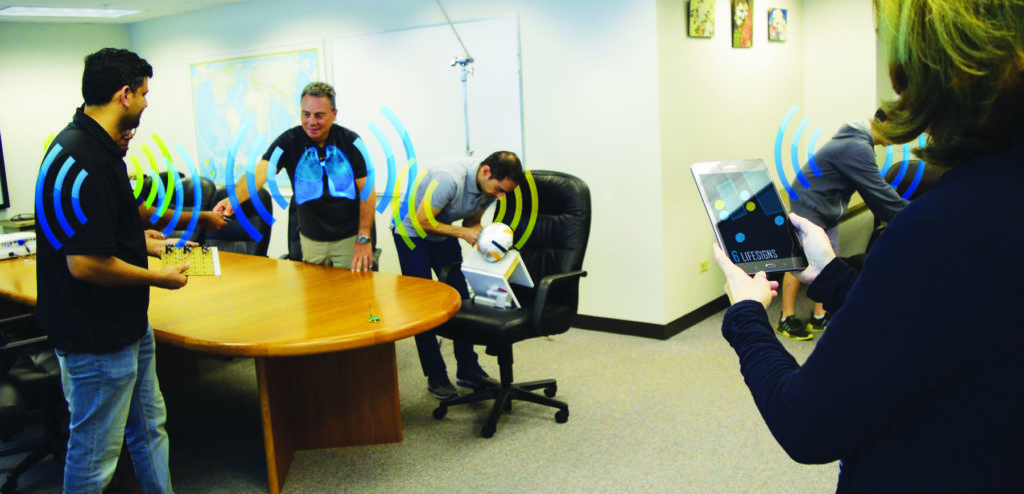In today’s high-tech world of building automation, occupancy detection systems are used to improve energy efficiency by cycling lights, proactively adjusting ventilation and temperature, and providing data for energy management systems in these so-called “smart buildings.” However, there are significant drawbacks to currently available passive infrared (PIR) and ultrasonic occupancy sensors, including high rates of false positives and failure to detect stationary persons, which contribute directly to inefficient energy usage in buildings. According to U.S. Department of Energy (DoE), reducing this inefficiency by only 2.5 percent annually would result in saving more than $80 billion per year.
Recognizing the drawbacks associated with current sensing technology, a husband and wife duo of electrical engineering professors from the College of Engineering at the University of Hawai‘i at Mānoa (UH Mānoa), Drs. Victor Lubecke and Olga Borić-Lubecke—used their research and knowledge to develop a more reliable sensor technology. They formed a startup called Adnoviv in 2013.
After receiving a $750,000 Small Business Technology Transfer (STTR) Phase II grant from the National Science Foundation in fall of 2018, Adnoviv has been focused on refining its new intelligent occupancy sensors—True Presence Occupancy Detection Sensors (TruePODS), and bringing the sensors to market to help Hawai’i achieve its ambitious goals of moving to 100 percent renewable energy and making the state fully carbon neutral by 2045.
TruePODS are the first occupancy sensors to employ Doppler radar technology to detect true human presence and occupant count in indoor spaces. TruePODS’ revolutionary approach to occupancy sensing goes beyond the current generation of simple motion sensors to actually detect human “life signs” such as respiration and heartbeat, thus eliminating common false triggering issues. Each sensor integrates the functionality for wireless monitoring and control as needed, whether through integration with a building control center or stand-alone operation with a smartphone app.
“Occupancy detection systems have been promising to enable proactive, data-driven energy management and more efficient use of real-estate, resulting in a significant impact on companies’ bottom lines,” says Victor Lubecke, co-founder and vice president of Adnoviv. “The TruePODS system has very high detection rates and can provide information on the number of occupants, which will allow companies to implement these advanced smart-building systems and realize these cost savings.”
TruePODS’ technology provides the solution to the reliability problems long associated with traditional occupancy sensors and currently limiting their widespread adoption and effectiveness. With more reliable and accurate performance (alleviating the cost and nuisance associated with erroneous power switching), TruePODS can provide 20 percent more energy savings over competitor products offered at a similar price and also avoid nuisance shut-offs with an up to 50 percent increase in presence recognition accuracy. The increase of occupancy detection accuracy converts directly to energy and hence cost savings. In addition to detection, TruePODS are compact in size allowing for easy integration into existing systems, and user-friendly for simple replacement and calibration.
In 2014, Adnoviv was awarded an STTR Phase I grant and in collaboration with UH Mānoa’s Hawai‘i Natural Energy Institute, demonstrated the superior performance of TruePODS compared to commercially available occupancy sensors by eliminating false triggering at the Flexible Response to Ongoing Growth (FROG) classrooms on UH campus. Adnoviv then participated in Phase I of the University of Hawai‘i’s accelerator program in 2015 and recently completed Phase II of the program earlier this year. The Adnoviv team has grown from two to more than seven in the process. “Adnoviv has served not only to move UH technology out of the lab and towards the market, but also to provide job opportunities for our graduates in Hawai‘i, and inspire some of our students to successfully pursue their own start-ups, said Borić-Lubecke, co-founder and president of Adnoviv. “While commercialization has not been an easy path, it has been a rewarding experience to witness our students growing into entrepreneurs and the University of Hawai‘i developing means to support such endeavors.”

